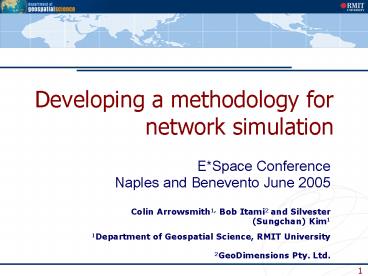Developing a methodology for network simulation PowerPoint PPT Presentation
1 / 57
Title: Developing a methodology for network simulation
1
Developing a methodology for network simulation
- ESpace Conference
- Naples and Benevento June 2005
- Colin Arrowsmith1, Bob Itami2 and Silvester
(Sungchan) Kim1 - 1Department of Geospatial Science, RMIT
University - 2GeoDimensions Pty. Ltd.
1
2
Methodology objectives
- to understand spatial behaviour of mobile objects
along networks - to develop typical itineraries for various types
of mobile objects - to model mobile objects along networks given
differing environmental conditions
2
3
Rationale
- predicted increases in traffic flow along
networks - physical constraints results in loss of amenity
and threats to safety - need to test management options under differing
scenarios
3
4
Methodology
- develop inventory of network
- survey design - detection, observation and
recording of mobile objects - developing typical itineraries for dynamic
objects - spatial analyses of movements
- identification of types of dynamic objects
- modelling movements
4
5
Develop inventory
- base spatial information acts as datum for
analyses and modelling
5
6
Survey design attributes required
- position
- duration
- sequence or itinerary
- flow
- speed and orientation
- type of object
6
7
Survey techniques
- questionnaire and interviewing
- video monitoring
- detectors and sensors
- tracking mechanisms including GPS
7
8
Itinerary determination
- identify network sequences
- classify network sequences
- statistical probability analyses
8
9
Spatial analyses
- extract topological linkages
- apply segmentation for analyses
- duration
- velocity
- diurnal patterns
9
10
Classification of types
- classification of object types using
- cluster or
- data mining techniques
- direct observation
10
11
Simulating movements and behaviour
- agent-modelling
- autonomous agents
- linked to GIS
- agent-rules
- wayfinding
11
12
Case study 1 Loch Ard Gorge
- objective
- to identify typical spatial behaviour patterns at
a popular tourist attraction - rationale
- increased visitation to tourist sites with
constrained physical parameters
12
13
Develop inventory for Loch Ard Gorge
13
14
Attractions
- 26 point attractions
- lookouts
- river
- car parks
14
15
(No Transcript)
16
(No Transcript)
17
(No Transcript)
18
(No Transcript)
19
(No Transcript)
20
(No Transcript)
21
Survey design
- GPS survey
- questionnaire survey
21
22
The GPS receivers used
22
23
GPS survey attributes
23
24
(No Transcript)
25
(No Transcript)
26
Topological linkages
26
27
(No Transcript)
28
Describing spatial-temporal data
- development of regions to assist in describing
movement patterns
28
29
(No Transcript)
30
(No Transcript)
31
Nodes visited
31
32
Visitor typologies
32
33
Simulation modelling
- RBSim3 is a computer model
- maintains a database of visitor experiences
through a simulation - itinerary can be built for an agent
- agent movement is modified by the changing
conditions of a network
33
34
RBSim Simulator
34
35
Case study 2 River Traffic Study
- objectives
- rationale
35
36
Objectives
- to determine the capacity of the Yarra and
Maribyrnong rivers to meet growing demands - identify management systems and infrastructure to
control boat traffic in a safe and sustainable
manner - develop a management strategy to control river
traffic
36
37
Rationale
- broad range of users and vessels with different
patterns of use - knowledge of impacts of different watercraft on
environmental and social conditions is uncertain - volumes of traffic predicted to increase
substantially - capacity of river has not been defined
37
38
Inventory development
- river depth
- bank conditions
- land and water facilities
- adjacent land use
38
39
Inventory development
39
40
Survey design
- interviews with user groups
- new river counts
- published schedules
- GPS tracking
40
41
GPS Tracking
41
42
Topological linkages
42
43
Patterns of movement
43
44
Boat types
- rowing boats
- commercial craft
- government vessels
- motor charter
- tug boats
- motor private
- ship
- non-motor sail
- sail under motor
- non-motor oar
- non-motor paddle
44
45
(No Transcript)
46
(No Transcript)
47
(No Transcript)
48
(No Transcript)
49
(No Transcript)
50
(No Transcript)
51
(No Transcript)
52
(No Transcript)
53
(No Transcript)
54
(No Transcript)
55
(No Transcript)
56
(No Transcript)
57
Conclusions
- developed a consistent methodology that can be
applied to model mobile objects along different
networks under different management scenarios
57

